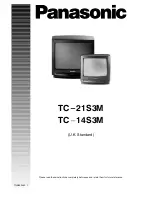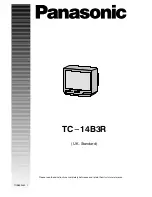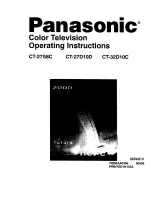
http://cxema.ru
– 9 –
KV-TF21M80
RM-952
5
Using Y
our New TV
Using Your New TV
Pr
eset the channels automatically
Tips
•
If you want to stop automatic channel pr
esetting, pr
ess SELECT twice.
•
If your TV has pr
eset an unwanted channel or cannot pr
eset a particular
channel, then pr
eset your TV manually (see page 10).
Note (KV
-HF14M80/TF21M80/XF21M83/XF21M80 only)
•
During automatic channel pr
esetting, your TV scr
een will indicate “B/G” ,
“I”, “D/K” or “M” for the TV system.
Now Y
ou Are Ready
. . .
To
watch your TV
, see page 12.
Notes
•
If you connect a monaural VCR, connect the yellow plug to
(the
yellow jack) and the black plug to
-L (MONO) (the white jack).
•
If you connect a VCR to the
˘
(antenna) terminal, pr
eset the signal
output fr
om the VCR to the pr
ogram number 0 on the TV
.
•
W
hen no signal is input to the connected video equipment, the TV scr
een
becomes blue.
Step 2
Note
•
Do not use old batteries nor use dif
fer
ent types of batteries together
.
Step 3
CAUTION
Do not connect the power cor
d until you have completed making all other
connections; otherwise a minimum leakage curr
ent might flow thr
ough the antenna
and other terminals to gr
ound.
Insert the batteries
into the r
e
mote
ONE
-PUSH AUTOMATIC
PROGRAMING
1
1
ONE-PUSH AUTOMATIC PROGRAMMING
1
2
VHF
LOW
AUTO
Fr
ont of TV
6
Using Y
our New TV
Connecting the 3D WOOFER
(KV
-XF21M83/XF21M93 only)
Y
ou can enjoy high quality sound by connecting the 3D WOOFER.
Rear of TV
W
OOFER (8
)
L(MONO)
3D WOOFER
Black wir
e
Red wir
e
1
2
1
Attach the 3D WOOFER into the footholds on the top of your TV
.
2
Connect the wir
es to the 3D WOOFER (8
Ω
) terminals at the rear of your TV
.
The red wire should be connected to the
‘
red terminal and the black wire
to the
’
black terminal.
Notes
•
Connect only the supplied 3D WOOFER; otherwise your TV may
malfunction.
•
Unplug your TV fr
om the wall outlet when connecting the 3D WOOFER.
•
T
o pr
event a malfunction caused by a short cir
cuit of the terminals, make
sur
e that none of the 3D WOOFER wir
e strands stick out, making contact
with the neighbouring speaker terminal.










































